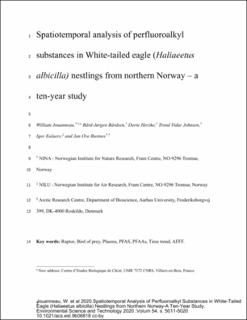| dc.contributor.author | Jouanneau, William | |
| dc.contributor.author | Bårdsen, Bård-Jørgen | |
| dc.contributor.author | Herzke, Dorte | |
| dc.contributor.author | Johnsen, Trond Vidar | |
| dc.contributor.author | Eulaers, Igor | |
| dc.contributor.author | Bustnes, Jan Ove | |
| dc.date.accessioned | 2021-04-06T08:38:07Z | |
| dc.date.available | 2021-04-06T08:38:07Z | |
| dc.date.created | 2020-06-17T09:59:13Z | |
| dc.date.issued | 2020 | |
| dc.identifier.citation | Environmental Science and Technology. 2020, 54, 5011-5020. | en_US |
| dc.identifier.issn | 0013-936X | |
| dc.identifier.uri | https://hdl.handle.net/11250/2736296 | |
| dc.description.abstract | The white-tailed eagle (Haliaeetus albicilla) in Scandinavia has suffered from impaired reproduction due to high exposure to industrial pollution between the 1960s and 1980s. While population numbers are rising again, new contaminants, such as per- and polyfluoroalkyl substances (PFAS), are increasingly found in high trophic avifauna and are of concern to potentially impact once again on population health. In the present study, we examined PFAS levels in plasma of white-tailed eagle nestlings from northern Norway over the last decade (2008–2017). While PFOA and PFNA exposure did not follow a significant time trend, PFOS and PFHxS concentrations decreased over time, and ≥C11 perfluorinated carboxylic acids only seem to level off during the last four years. This may in fact be the first evidence for a change in the trend for some of these compounds. Furthermore, since several PFAS are expected to be highly present in aqueous film-forming foams used at airports, we also investigate the potential of the two main airports in the region to act as hotspots for PFAS. Our results indeed show decreasing exposure to PFOA with distance to the airports. Altogether, our results seem to show that legislation actions are effective, and continued concern for PFAS exposure of high trophic wildlife is still warranted, even in the northern environment. | en_US |
| dc.language.iso | eng | en_US |
| dc.title | Spatiotemporal Analysis of Perfluoroalkyl Substances in White-Tailed Eagle (Haliaeetus albicilla) Nestlings from Northern Norway-A Ten-Year Study | en_US |
| dc.type | Peer reviewed | en_US |
| dc.type | Journal article | en_US |
| dc.description.version | acceptedVersion | en_US |
| dc.rights.holder | Copyright © 2020 American Chemical Society | en_US |
| dc.subject.nsi | VDP::Zoologiske og botaniske fag: 480 | en_US |
| dc.subject.nsi | VDP::Zoology and botany: 480 | en_US |
| dc.source.pagenumber | 5011-5020 | en_US |
| dc.source.volume | 54 | en_US |
| dc.source.journal | Environmental Science and Technology | en_US |
| dc.identifier.doi | 10.1021/acs.est.9b06818 | |
| dc.identifier.cristin | 1815905 | |
| dc.relation.project | Norges forskningsråd: 255681 | en_US |
| dc.relation.project | Framsenteret: Flagship Hazardous Substances | en_US |
| dc.relation.project | NILU - Norsk institutt for luftforskning: 114063 | en_US |
| cristin.ispublished | true | |
| cristin.fulltext | postprint | |
| cristin.qualitycode | 2 | |
